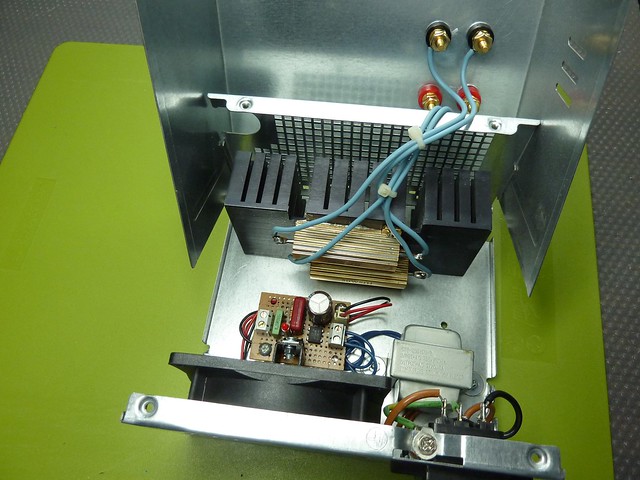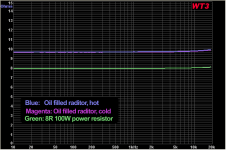 Thread split off from Speaker Voltage Test
Thread split off from Speaker Voltage Test_________________________________________________________________________________________________
... But most people here dont have a scope and dummy load, so cant test directly as you can...
About the scope I can't help, but as for the dummy load I can show how I built mine, since this is a DIY forum. Forgive the somewhat off topic, though.
Dummy Load made with a little help of a computer ATX Power supply and P2 CPU heatsink.

The board was built actually for another project, since it has an unused 5 volt output. This internal power supply is dedicated to the 12v FAN, and could be built only with the 9v transformer, the small bridge rectifier (or even single diode will do), and the smoothing capacitor (could be something like 470uF 25V).
The resistors are 8 Ohm 50W, screwed to the heatsink, and using thermal compound.

This Load does not behave as a speaker, obviously, but will save your hears from excruciating frequencies playing loud wile testing amplifiers.
This is just an idea. One can use other resistor values, combinations of resistors to be able to simulate, 4 and 16 Ohm loads, and of course higher power resistors than the 50w I used, provided the adequate cooling of those.
Cumps
I don't worry about my 1500 watt load resistors getting hot, since I use space heaters. The 1500 watt setting (900 + 600 watt) is 9.6 ohms, two heaters on the 900 watt setting comes out to 8 ohms. After burning up a power amp from shorted clip leads connecting the heatersI have some big 4R and 8R dummy loads that came from Parts Express. They DO get hot. That's a clever way to cool them.
Toasters, toaster ovens, 1000 watt par lamps and engine block or radiator heaters (in a water bucket) all make good high power load resistors.
Art
Two 9 ohm loads in parallel would be only 4.5 ohms, 3200 watts at 120 volts (12,800 watts at 240 voltsArt, we must have the same heaters, or close.I think mine are 9 ohm for each element- each heater has two elements. They make for an excellent high power load.
All my larger oil filled space heaters (Patton, Duracraft, Delongi) use 900 watt (around 16 ohm) and 600 watt (around 24 ohm) elements so they can run on a typical (old school) 15 amp 120 volt circuit.
Some of the smaller heaters are only 500 watts, about 29 ohms.
I did when doing PA amp comparisons. Many "high powered" amps can't deliver their rated power for more than a fraction of a second without current limiting or popping a breaker, for high powered sub use they don't cut it.Do you really test that much RMS power into a dummy load ... ?
Art
Been awhile since I checked. You're right, probably 9 ohms with both elements in.Two 9 ohm loads in parallel would be only 4.5 ohms, 3200 watts at 120 volts
Easy enough to test.Light bulbs yes, for sure. Do heaters really change much?
Heat it up, Remove power and then put an multimeter on it while it cools. Preferably analogue.
Yes.Light bulbs yes, for sure. Do heaters really change much?
They probably run @ 500°C
That is the same problem as being ignored by users of Aluminium encased small but high power load resistors. The attached heatsink is apparently fairly cool but that has little to do with the resistance element temperature !!!!!!
The wire inside runs VERY HOT.
An 8r0 resistor wire is no longer operating at the Ta when one checked the resistance.
Yes.
They probably run @ 500°C
You think ?
An oil filled radiator surely doesn't get "that" hot that the resistance of the element changes. Maybe a few % at most but nothing more. Easy to check with a plug in power meter do-dah. Its like an immersion heater, or shower, they don't vary in power consumption with regard to temperature.
Just measured a 1.5kw element (oil filled rad) and its 36 ohms. At 230vac that's a fraction under 1.5kw
Oil filled will be much lower operating temperature for the element.
The red (infra red/glowing incandescent) element heaters will be much higher operating temperature.
The element inside a water heater tube will be hot, the element inside an old storage radiator will be hot, the element inside an electric kettle heater will be hot.
The red (infra red/glowing incandescent) element heaters will be much higher operating temperature.
The element inside a water heater tube will be hot, the element inside an old storage radiator will be hot, the element inside an electric kettle heater will be hot.
The element inside a water heater tube will be hot, the element inside an old storage radiator will be hot, the element inside an electric kettle heater will be hot.
Storage heaters I am expert on
They don't change appreciably with temperature, in fact the "modern" heaters use individual 850 watt elements and these are used in multiples to make the larger heater sizes such as 2.55kWh or 3.4kWh. They don't change in resistance as they heat.
Storage heaters I am expert onas we are all electric and the bricks in those are heated to extremely high temperatures
They don't change appreciably with temperature, in fact the "modern" heaters use individual 850 watt elements and these are used in multiples to make the larger heater sizes such as 2.55kWh or 3.4kWh. They don't change in resistance as they heat.
How's the inductance?
How's the inductance?
On a storage heater
For those of you who like to worry about such things, below you will find impedance plots of a sand filled, aluminum heatsink 100W power resistor and a 1550W little oil filled radiator heater. Plotted both hot and cold.
Attachments
- Status
- This old topic is closed. If you want to reopen this topic, contact a moderator using the "Report Post" button.
- Home
- Design & Build
- Equipment & Tools
- Power Soaks and Dummy Loads
